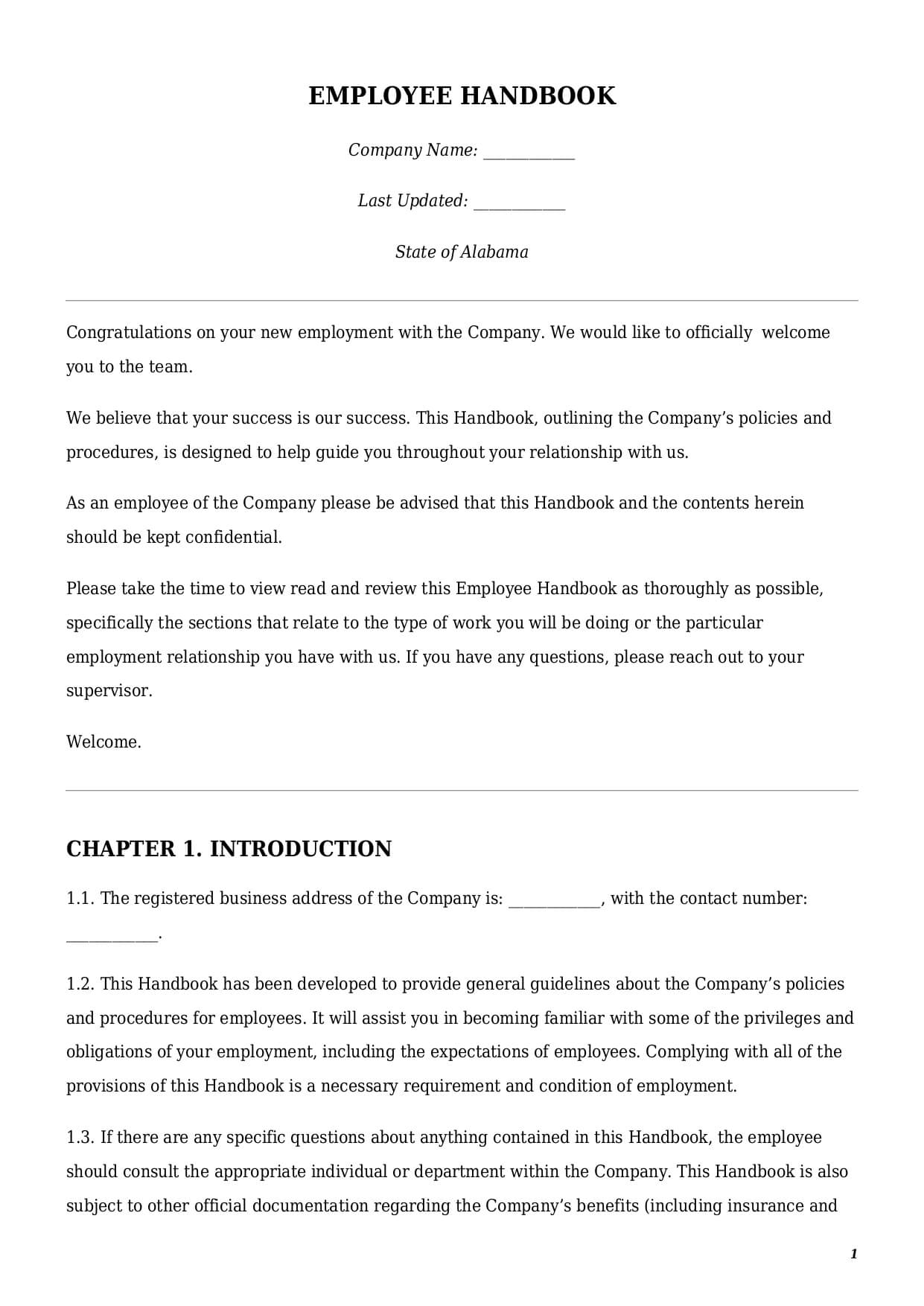Employee Handbook
Reviews


What Is an Employee Handbook?
An employee handbook is a formal legal document that outlines a company’s internal policies, goals, culture, values, procedures, and expectations from employees. An employee handbook is also known as a workers handbook or staff handbook. Despite the title, it remains the same document with the same purpose.
An employee handbook is also known as a company’s internal constitution, as it is the most senior corporate document. Think about an employee handbook as a road map that guides all employees in their daily work and communication.
A company handbook template serves as a centralized guide not only for employees but also for a company’s management. It helps to clarify procedures a company’s management should follow. An employee handbook outlines:
- probation period;
- protection of employee’s privacy;
- safety of work environment;
- dress code;
- payment information (e.g., salaries, promotions, overtime);
- social media policy;
- code of conduct;
- benefits and perks for employees (e.g., dental insurance);
- conflict of interest policy; and
- vacation and days off.
An employee handbook template is suitable for both a small business like a startup and a well-established organization.
A written employee manual format ensures employees know where to find vital information and can consult it at any time. A company handbook template can be created and published in several ways:
- as a written manual. In that case every employee should have a right to access such a workers handbook any time (e.g., a written copy of the employee handbook can be kept with HR, or its hard copy could be provided to every employee in person).
- as an electronic document. An employee handbook could be published on the company’s intranet, website, or internal corporate database. This is the easiest way to keep such a staff handbook up to date as well as to make it accessible for employees 24/7.
Purpose of Employee Handbook
The purpose of an employee handbook is to provide employees with a clear and consistent understanding of their rights, responsibilities, and the company’s policies. It can also function as legal protection in the event of disputes. There are a number of reasons why having a company handbook template is a must:
- Communicate all binding rules in one document;
- Explain benefits and perks employees have access to;
- Clarify HR procedures for sick leaves, discipline, grievances, termination, harassment, or bullying;
- Build and maintain company culture;
- Reduce significantly risks of internal conflicts and further legal disputes.
Employee Handbook’s Coverage
It is evident that the employee handbook applies to a company’s employees. At the same time, a company’s management may exempt employees who work remotely or part-time from its application. A staff handbook cannot also apply to contractors and workers who perform their work by virtue of service agreements or independent contract agreements.
How To Make an Employee Handbook?
If you’re wondering how to write an employee handbook, you’re not alone. Here are the basic steps you have to follow to create an employee handbook suitable for your business:
1. Values Come First
Start with summarizing basic values and goals your business pursues daily. Defining a company culture clearly helps employees to better perform as well as to understand what is expected from them.
2. Use staff handbook template
An employee handbook includes various provisions, which makes it a long and complex document. Drafting employee handbook templates from scratch might be daunting. FasterDraft offers you an opportunity to make a custom employee handbook in a few minutes.
3. Think about Policies
Consider carefully which aspects of the company’s life you intend to cover in an employee handbook. They may include work performance, vacations, leaves, military or jury duty, salaries, annual appraisals, and many more. All that should be addressed and regulated directly in an employee handbook.
4. Thing about Structure
A staff handbook template should have a logical structure and be easy to read. Make it as reader-friendly as possible. Avoid using too complex language.
5. Employee handbook acknowledgement form
An employee handbook becomes legally binding for an employee once it is directly communicated to them. Think about how you plan to communicate this document—in person, via email, or perhaps via ticking a special box in a company’s internal portal.
6. Consult a lawyer
You may wish to consult your lawyer about the creation or further application of an employee handbook within your company.
7. Avoid using free employee handbook template
It might be appealing to use samples of employee handbooks available online for free. However, we do not recommend doing so, and here is why. Firstly, those samples may include sections and chapters that are not relevant for your organization or company’s structure. Secondly, free examples of employee handbooks may not be updated or contradict employment laws.
What Should Be Included in an Employee Handbook?
Neither federal law nor state laws define the exact structure every employee handbook should include. It depends on a company’s size, structure, and goals. A good example of employee handbook includes
1. Introduction Part
This is where employees get to know their company’s history, goals, and core values. It usually includes a short welcome letter for new employees as well.
2. Basic Employment Rules
This chapter of a handbook includes information about:
- employee’s coverage
- equal opportunity statement
- types of employment (e.g., part-time, full-time, remote work).
3. List of Workplace Policies
Despite if it is a small business or a big high-tech company, a good sample employee handbook should include
- Anti-harassment and discrimination policies;
- Drug and alcohol policies;
- Attendance and punctuality expectations;
- Grievance policies; and
- Social media policies and many more.
4. Compensation & Benefits
A great employee handbook should include detailed regulation:
- for payroll schedule and overtime policy;
- promotion, employees’ incentive plans, and insurance;
- PTO, sick leave, maternity leave, and many more.
5. Code of Conduct
Code of conduct at the workplace may include dress code policies, ethics and confidentiality, use of company property and internet, and so on. It may also cover employment of close relatives within the same company, as well as limitation of personal and close relations between the co-workers.
6. Disciplinary Procedures
Good examples of employee handbooks usually include detailed disciplinary procedures for employees who violate the employee handbook. Usually those procedures include measures to be taken to improve the situation as well as applicable disciplinary measures (e.g., termination of employment, fines, refusal of promotion, etc.).
Employee Handbook Requirements by State
Employee handbook requirements by state vary significantly in the U.S. It’s vital to customize your handbook according to local employment laws. For example:
- For the California employee handbook, it is mandatory to adopt meal break policies for a company with 5 or more employees. and paid sick leave.
- For employee handbook Colorado, it is essential to have a clear anti-discrimination policy in place.
- If you create employee handbook template Texas, make sure you have a lactation accommodation policy in place.
How Often Should an Employee Handbook Be Updated?
There is no requirement for how often an employee handbook should be revised. If you are a business owner or work in the HR department, make sure that samples of employee handbooks are updated each time:
- when employment laws change (state and federal);
- company’s management introduces new regulations or new policies; or
- company undergoes internal structural changes.
Even if no major change occurs, an annual audit of your employee handbook template helps ensure that your policies stay relevant and effective.
Get Your Employee Handbook Template Online
At FasterDraft, you can create a customized employee handbook template. Simply follow the steps below:
- Press the button “Create Document.”
- Answer a few questions in the questionnaire;
- Select a document format: Employee Handbook Template PDF or Word.
- Insert a signature (optional);
- Make a payment;
- Get your customized employee handbook sample for download.
Table of content
Frequently Asked Questions (FAQ)
-
1. Are Employee Handbooks Required By Law?
Not in all cases. There is no federal law requiring private companies to create an employee handbook. At the same time, legislation in certain states may outline that having an employee handbook is a must.
Even if it’s not mandatory, maintaining a handbook is strongly recommended for managing policies and mitigating legal risks.
-
2. Do Small Businesses Need an Employee Handbook?
An employee handbook template could be helpful for both small and big companies. The staff handbook is an important internal manual that guides the daily work of a company and its employees.
-
3. Is an employee handbook a contract?
Yes, an employee handbook is a complex contract between staff and the company’s management that outlines work performance, discipline, and workplace regulations in general.

Looking for something Different?
Start typing to find out our collection of legal documents and contract templates
